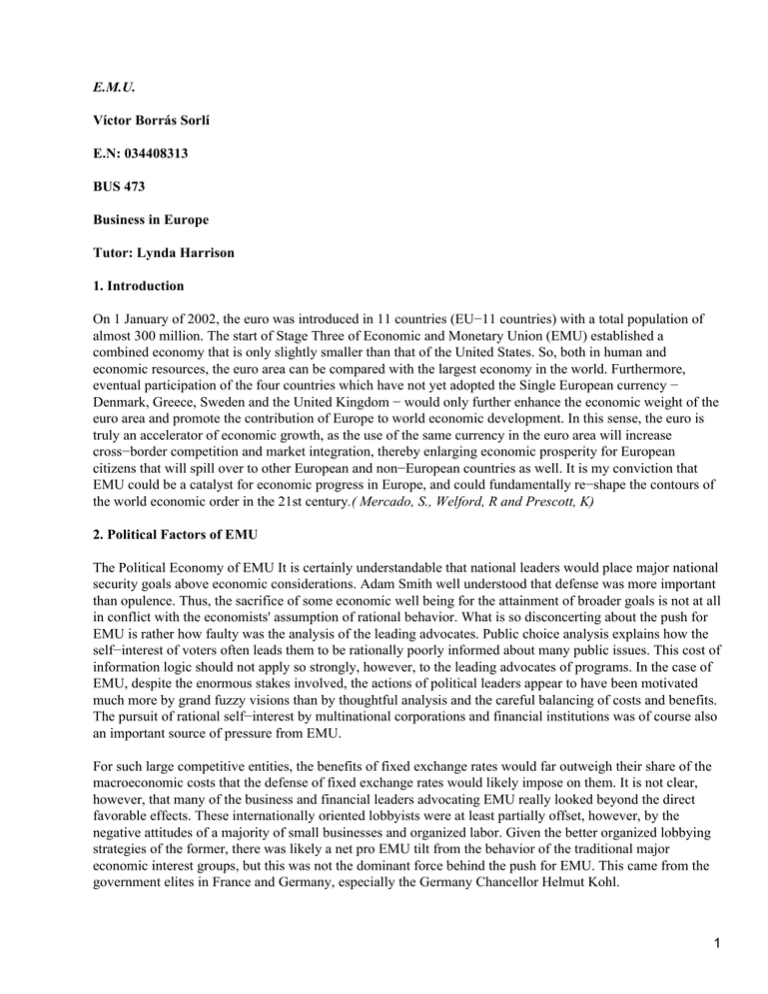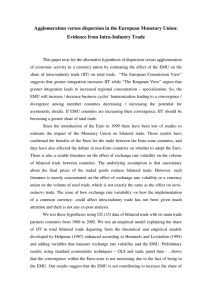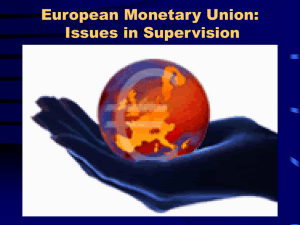Economic and monetary union
Anuncio

E.M.U. Víctor Borrás Sorlí E.N: 034408313 BUS 473 Business in Europe Tutor: Lynda Harrison 1. Introduction On 1 January of 2002, the euro was introduced in 11 countries (EU−11 countries) with a total population of almost 300 million. The start of Stage Three of Economic and Monetary Union (EMU) established a combined economy that is only slightly smaller than that of the United States. So, both in human and economic resources, the euro area can be compared with the largest economy in the world. Furthermore, eventual participation of the four countries which have not yet adopted the Single European currency − Denmark, Greece, Sweden and the United Kingdom − would only further enhance the economic weight of the euro area and promote the contribution of Europe to world economic development. In this sense, the euro is truly an accelerator of economic growth, as the use of the same currency in the euro area will increase cross−border competition and market integration, thereby enlarging economic prosperity for European citizens that will spill over to other European and non−European countries as well. It is my conviction that EMU could be a catalyst for economic progress in Europe, and could fundamentally re−shape the contours of the world economic order in the 21st century.( Mercado, S., Welford, R and Prescott, K) 2. Political Factors of EMU The Political Economy of EMU It is certainly understandable that national leaders would place major national security goals above economic considerations. Adam Smith well understood that defense was more important than opulence. Thus, the sacrifice of some economic well being for the attainment of broader goals is not at all in conflict with the economists' assumption of rational behavior. What is so disconcerting about the push for EMU is rather how faulty was the analysis of the leading advocates. Public choice analysis explains how the self−interest of voters often leads them to be rationally poorly informed about many public issues. This cost of information logic should not apply so strongly, however, to the leading advocates of programs. In the case of EMU, despite the enormous stakes involved, the actions of political leaders appear to have been motivated much more by grand fuzzy visions than by thoughtful analysis and the careful balancing of costs and benefits. The pursuit of rational self−interest by multinational corporations and financial institutions was of course also an important source of pressure from EMU. For such large competitive entities, the benefits of fixed exchange rates would far outweigh their share of the macroeconomic costs that the defense of fixed exchange rates would likely impose on them. It is not clear, however, that many of the business and financial leaders advocating EMU really looked beyond the direct favorable effects. These internationally oriented lobbyists were at least partially offset, however, by the negative attitudes of a majority of small businesses and organized labor. Given the better organized lobbying strategies of the former, there was likely a net pro EMU tilt from the behavior of the traditional major economic interest groups, but this was not the dominant force behind the push for EMU. This came from the government elites in France and Germany, especially the Germany Chancellor Helmut Kohl. 1 The major motivation was a highly worthy one − limiting the possibilities of a future intra European war. But good intentions are not an adequate substitute for sloppy analysis. In essence, the primary promoters of EMU failed to understand the difference between marginal and total benefits and the difference in patterns of economic effects between trade liberalization and the formation of a common currency. (See Willett (1994). Simply put, the push for EMU by the political elites of Europe was the poorly thought out continuation of the European project started in the early post war period. Jean Monnet's idea was that the creation of greater economic linkages within Europe would foster a web of political ties that would eventually make a repeat of the World Wars unthinkable among the participating countries. Such an idea seems quite naïve to a cynical realist, but the amazing fact is that it worked. Despite the unfortunate step of making the costly and inefficient Common Agricultural Policy a centerpiece of the European integration movement, the move through the common market to the single European market brought both substantial economic benefits and the desired political spillovers. Monnet's vision ultimately worked. Economic arrangements had already done virtually all that they could to in Kohl's phrase contain a potentially dangerous Germany within Europe. But European leaders appear to have come to think of economic integration as an institutional process that must always be ongoing. This is sometimes referred to as the bicycle theory. If you don't keep moving forward, you'll fall over. Thus, with the successful completion of the negotiations for the single market − Europe 1992 − leaders began to look around for the next economic project and monetary union was the last remaining candidate for a big push. Of course, fears of possible adverse implications of Germany reunification heightened concerns with binding Germany more strongly to Europe. While such fears seem to me to have been quite exaggerated, they had considerable impact on political elites in Europe. Normally, in international negotiations over macroeconomic and exchange rate policy coordination, national governments are, if anything, excessively jealous of preserving national autonomy. Thus, coordinated policy actions are so seldom achieved. On this basis, the chances for EMU would be almost nil. With discussion framed with the context of the European project, however, it is as if a different set of mental models were adopted and the traditional concerns with preserving national macroeconomic sovereignty were set aside. Thus it is not surprising that the UK, always much more ambivalent about the European project than France or Germany, did not succumb to this switch in mental models and as a consequence did not go along with the first wave of fervor for the EMU. The leaders of the political push for EMU seemed totally unaware of the considerations emphasized by economists in the theory of optimum currency areas. They stressed economic benefits as a sales technique, but it was clear that their basic objective was political, and discussion of EMU quickly took on all the signs of ideological debate. It is perhaps because economists in America have been less caught up in these ideological dimensions that they have tended to pay much more attention to the prospective costs of EMU than have European economists on average. A particularly dangerous oversight of the European political elite was to ignore the warnings of OCA theory that the sign of the net economic costs−benefits equation of monetary union can vary across countries. Some countries would have net benefits, others net costs. There will be differences in the patterns of the internal gains and losses across countries from trade liberalization and there may be differences in the size of the net gains across countries, but the divergences in these national cost−benefit ratios from trade liberalization are likely to be quite small compared with the pattern from broad monetary unification. By any reasonable interpretation, broad monetary union fails the test of subsidiary. It may be welfare enhancing for a core group of members, but clearly not for the full set of EU members .Yet the political dynamic unleashed by the French and German governments led to the enshrinement of monetary union as the test of European commitment and membership in the true European club. Part of the motivation of the push for EMU clearly went beyond concern with war prevention to goals of greater European political integration, but these goals were typically only vaguely perceived and based on incompatible expectations of 2 French and German elites about what a more politically integrated Europe would look like. Little concern was given to attempting to develop broad based public support for the project and the combination of this with the inevitable adverse economic effects of monetary union on some countries is likely to generate a good deal of political tension. Thus even viewed in political terms alone, there is a good chance that the net effects will be the opposite of those initially anticipated by key EMU supporters. It may well prove true that critics such as Feldstein have been too pessimistic in their analyses of the political tensions that will be generated within Europe as a result of EMU, but what is distressing from the standpoint of models of rational decision making is that there is little indication that the political elites of France and Germany paid any serious attention to analyzing such possibilities before leaping to their support of EMU. Rather, what seems dominant in the case of the push for EMU was the power of a fuzzy idea in framing the issue in the minds of key leaders. Once these mental commitments were made, there was no turning back. The perseverance of the French is the easiest to understand. Given their long standing distaste for flexible exchange rates and the difficulties of running adjustably pegged regimes in a world of high capital mobility that had been demonstrated once again in the crises of the European Monetary System in 1992 and 1993, the French felt committed to a hard currency peg against the German mark. Thus having already effectively given up domestic monetary independence, it is easy to see how the French perceived an interest in transferring the de facto control of their monetary policy from the Bundesbank to a group decision−making process through a European Central Bank. The same type of analysis applies to the smaller economies of Austria, Belgium, and the Netherlands that had adopted hard currency pegs against the DM. The difficult question is why would Germany be willing to agree to give up its monetary independence. While some economic considerations such as concern with trade competitiveness may have played a minor role, there is little question that the dominant concern was the desire of Helmut Kohl and much of the rest of the German policy elite to tie Germany even more strongly to Europe. At the same time, some attention would be paid to Germany's traditional concern with monetary stability by providing tight entry criteria which would limit at least the initial stage of EMU to a small group of sound money countries. The political discord that would likely have been generated by such a split of ins and outs along North−South lines within Europe appears to have been of little consideration at this stage. In the event, however, this split did not come about. A combination of desires to import discipline and, more importantly, to not be left out of the new inner European club led to strong pushes by the leaders of the Southern countries to meet the initial conditions for entry. Meanwhile loose interpretations of the Maastricht entry criteria facilitated the initial creation of a large EMU rather than the small one the German government had envisioned.(Wallace and Wallace) 3. Economic Factors − The Benefits of EMU After addressing political factors and how its influence on the EMU, other economic benefits may also be derived together with the political factors. The benefits of EMU and the introduction of the euro and the single monetary policy should result in higher economic growth in the euro area and thereby contribute positively to the development of the world economy. The degree to which these benefits are achieved depends not only on the monetary policy of the Eurosystem, but even more so on accompanying stability−oriented fiscal and appropriate labour market policies. When speaking of the Eurosystem, I refer to the European Central Bank (ECB) and the eleven national central banks (NCBs) of the participating Member States. The most important contribution that the Euro system's monetary policy can make towards exploiting to the maximum the benefits of EMU is to fulfil its primary objective to maintain price stability, as stipulated in the Treaty on European Union. As has long been argued by central bankers and academic economists, inflation is costly, both economically and socially • Nobel prize−winner Milton Friedman expressed this well in 1980, when he said : "Inflation is a disease, a dangerous and sometimes fatal disease, a disease that if not checked in time can destroy a society" • The same could be said about deflation. In my view, EMU is a tool to consolidate the progress made 3 towards price stability in recent years and to firmly anchor expectations in line with price stability, and thereby establish the necessary framework to seize the opportunities of monetary union. The Euro system enjoys full independence to determine the appropriate level of interest rates in order to satisfy its primary objective of price stability. Moreover, the members of the ECB Governing Council have long terms of office and are only dismissible for serious misconduct or inability to perform their duties. These provisions imply that the concept of monetary stability benefits from explicit legal statutes and that the credibility of the Eurosystem will be safeguarded by protecting the monetary policymaking process from political interference. A further important benefit of EMU is that it has greatly reduced the risk of real exchange rate misalignments within the euro area. This fosters economic growth and avoids a misallocation of resources. In fact, it enables the European Single Market to function smoothly to the advantage of producers and consumers. EMU has eliminated nominal exchange rate volatility and exchange rate risks within the euro area. This benefits not only trade between, and economic growth in, the euro area countries but also the economic development of other European and non−European countries. In addition, foreign direct investments into the euro area economies should be promoted, as these investments are negatively affected by exchange rate volatility. The advantages of economic integration afforded by the Single Market process are enhanced by the elimination of the transaction costs of exchanging different currencies, the direct result of the introduction of the euro. Furthermore, the single currency will make prices across the euro area directly comparable, which should increase competition and hence efficiency and economic growth in the euro area. A number of further positive effects on economic growth flow from the elimination of separate currencies in the euro area countries. One benefit is the potential for the reduction of risk premier built into real interest rates. This in turn will stimulate investment. By facilitating the development of deep and integrated capital markets, the single currency should further reduce long−term rates via the elimination of premier resulting from less liquid markets. For example, empirical research has shown that due to more liquid markets, US long−term interest rates are 25 to 50 basis points lower than comparable European interest rates. In addition, a wider and deeper capital market in the euro area will improve intermediation between savers and investors. Finally, EMU may stimulate further political integration of Europe. In general, the process of European integration has been driven and continues to be driven by the political conviction that an integrated Europe will be safer, more stable and more prosperous than a fragmented Europe. In this sense, the introduction of a single currency in the euro area could become an important symbol of political and social integration in Europe. It could serve as a catalyst for further integration in other areas. (De Grauwe)( Mercado, S., Welford, R and Prescott, K) 4. Conclusions I am convinced that Economic and Monetary Union provides a great opportunity to create and maintain a large zone of price stability and economic prosperity in Europe, including a substantial reduction of unemployment. However, while price stability is a necessary condition for fully grasping the opportunities of EMU, it is not in itself sufficient. Stability−oriented polices regarding the development of national fiscal positions and the functioning of labour markets are of crucial importance as well. As I have discussed, the benefits of EMU will not arise in a quasi−automatic way. While monetary policy will deliver its contribution by following policies that maintain price stability, other economic policies must be implemented to ensure that the opportunities of the single currency will be fully utilised. Monetary policy alone − however well designed and implemented − cannot solve Europe's economic problems. Policy−makers in all areas must be determined to take the new environment of Stage Three of EMU and its consequences appropriately into account when forming their policies. Only then will the euro be able to function as a truly accelerator of economic growth in Europe. The German trade off strategy fell flat. Apart from some increase in the power of 4 the European Parliament, little in practice has come from the supposed linkage of monetary union and political union. Indeed the meaning of the latter is still quite unclear 5. Bibliography − References: • El−Agraa A., (2001) The European Union, Prentice Hall, Chapter 6 • De Grauwe, (1997) The Economics of Monetary Integration, 3rd Revised Edition • Mercado, S., Welford, R and Prescott, K., (2001) European Business Prentice Hall Chapter 4 • Wallace and Wallace, (2000) Policy Making in the European Union, OUP, Chapter 6 • Wren− Lewis, Simon, The Economics of EMU: a simple guide to the pros and cons. New Economy, March 2001, pages 3−8 Internet Web Pages: http://www.amue.org http://wwweuroscanner.com/eng/ 6 5

